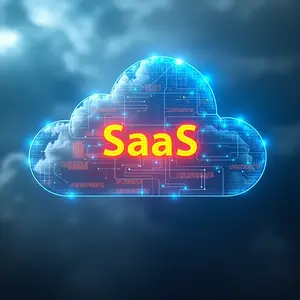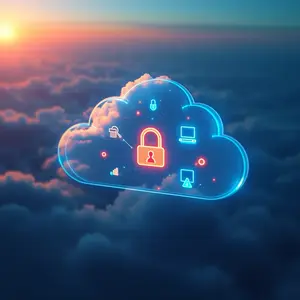Software as a Service (SaaS)
Explore our comprehensive range of secure and reliable Software as a Service (SaaS) solutions. Boost collaboration, streamline workflows, and enhance your business agility.
What Is Software as a Service (SaaS) and How Does It Work?
Software as a Service (SaaS) is a cloud computing model in which software applications are delivered over the internet as a subscription-based service. Users access software through a web browser or a lightweight client instead of installing and maintaining software on local hardware. SaaS operates on a multitenant architecture, where multiple users share the same application infrastructure while maintaining data separation and security. This model resembles leasing a highly maintained office building, where tenants enjoy shared resources like security, maintenance, and utilities without direct ownership. Common examples include Microsoft 365, Salesforce, Google Workspace, and Zoom. Platforms are hosted on cloud providers such as Amazon Web Services, Microsoft Azure, and Google Cloud, leveraging their infrastructure for availability and scalability. According to Statista, global SaaS revenues are projected to reach $232 billion by 2024, with over 70 percent of businesses relying on at least one SaaS application. Consequently, SaaS offers flexibility, speed of deployment, and reduced capital expenditures.

What Are the Advantages of Using SaaS for Business?
SaaS delivers numerous advantages, including reduced upfront costs, rapid deployment, automatic updates, and scalability. Subscription models eliminate the need for hardware purchases and lengthy installation processes. Centralized management simplifies administration and security oversight. The vendor applies Updates and patches automatically, ensuring compliance and reducing risk. Multi-user access allows teams to collaborate in real time, often from different locations. One marketing agency adopted SaaS-based CRM software without training its staff, leading to confusion and inconsistent data entry. After implementing role-based access, conducting a formal onboarding process, and customizing workflows, productivity increased and data accuracy improved. Moreover, the CRM solution met GDPR compliance through built-in encryption and audit logs. Accordingly, SaaS streamlines operations and supports growth when configured and maintained with attention to business needs.
How Is SaaS Different From Traditional Software?
Traditional software requires installation on local devices and often involves complex licensing agreements, version control issues, and ongoing maintenance. In contrast, SaaS applications are hosted in the cloud, maintained by the provider, and accessible from any internet-connected device. Traditional setups limit user access and require manual updates, creating team inconsistencies. SaaS centralizes access and ensures all users operate on the latest version. One law firm ran on-premise document management software that required weekly manual updates. Delays caused missed security patches, eventually leading to a ransomware infection. Transitioning to a SaaS-based platform with real-time backups, endpoint protection, and centralized logging eliminated similar risks. Moreover, the new solution supported compliance with HIPAA data security requirements through automatic encryption and two-factor authentication. Consequently, SaaS modernizes operations by replacing complexity with convenience and control.
What Are Common Security Considerations for SaaS?
Security in SaaS environments includes identity management, encryption, endpoint protection, and secure data storage. To prevent unauthorized entry, access should be governed by single sign-on (SSO) and multi-factor authentication (MFA). Data must be encrypted in transit and at rest, using standards such as AES-256 and TLS 1.3. Secure software development practices and penetration testing further reduce risk. One financial services firm failed to restrict administrative permissions on a SaaS accounting tool, allowing an intern to accidentally delete client records. After implementing role-based access and audit logging, user activity became traceable, and permissions aligned with job roles. Moreover, PCI-DSS compliance was restored by enabling secure API endpoints and limiting data export features. Accordingly, SaaS security must be managed through vendor selection, configuration, and monitoring practices.
How Can SaaS Support Remote and Hybrid Work Models?
SaaS facilitates distributed work environments by providing browser-accessible applications that require minimal hardware configuration. Cloud-native tools offer integrated chat, file sharing, and collaboration features that mimic in-office workflows. Applications like Slack, Microsoft Teams, and Asana enable teams to coordinate tasks, share feedback, and monitor progress asynchronously. Virtual desktop infrastructure (VDI) options offer additional control for regulated industries. One educational institution struggled to support remote staff during a sudden office closure, relying on VPNs and patchy file access. By switching to a SaaS learning management system and productivity suite, educators accessed materials securely from any device while IT gained centralized oversight. Moreover, FERPA compliance was maintained through role-based data segmentation and encrypted user sessions. Consequently, SaaS bridges the gap between physical and digital workspaces.

What Happens When a SaaS Platform Experiences Downtime?
SaaS platforms rely on distributed infrastructure to maintain high availability, but outages may occur due to regional service disruptions, software bugs, or misconfigured updates. Downtime can impact productivity and customer satisfaction, especially without a proper business continuity plan. Providers typically offer service-level agreements (SLAs) detailing uptime guarantees and response times. One e-commerce business operated entirely on a SaaS storefront that experienced three hours of unexpected downtime during a holiday promotion. Lacking redundancy or communication protocols, customer trust declined, and sales were lost. The business minimized future exposure after migrating to a SaaS provider with multi-region redundancy and real-time service dashboards. Moreover, incident response procedures were updated to include failover plans and client notifications. Accordingly, platform reliability must be assessed alongside features and pricing during vendor selection.
How Can SaaS Integrate With Existing Systems?
SaaS platforms support integration through APIs, middleware, and automation tools. Platforms such as Zapier, MuleSoft, and Microsoft Power Automate enable secure data exchange between SaaS applications and on-premise systems. RESTful APIs allow real-time CRM, billing, and customer support software synchronization. One manufacturing company used separate sales, inventory, and customer service systems, resulting in redundant data entry and reporting delays. By integrating SaaS solutions with ERP data via secure webhooks, operations became more efficient, and data consistency improved. Moreover, audit trails created during integration supported ISO 27001 documentation requirements. Consequently, SaaS platforms become more powerful when connected through seamless automation and secure data flows.
How Does SaaS Support Regulatory Compliance?
SaaS vendors provide frameworks and tools to help clients comply with industry-specific regulations. Compliance support includes encryption standards, audit logging, access controls, and geographic data residency options. Vendors often publish compliance certifications such as SOC 2, HIPAA, GDPR, and PCI-DSS on their trust pages. One nonprofit storing donor records selected a SaaS donor management system without verifying its compliance standing. The organization faced regulatory scrutiny after a data export exposed personal details. The nonprofit met applicable data privacy requirements by switching to a certified provider and enabling audit logging, permission tracking, and regional data storage. Moreover, built-in breach notification workflows ensured timely reporting under GDPR obligations. Accordingly, regulatory alignment depends on the provider’s infrastructure and the customer’s configuration practices.
What Long-Term Benefits Does SaaS Offer Organizations?
SaaS improves business agility, reduces infrastructure costs, supports remote access, and encourages innovation. Subscription pricing aligns with usage, allowing predictable budgeting and reduced capital investment. According to Flexera’s 2023 State of the Cloud Report, 89 percent of organizations cite cost savings and accelerated time-to-value as key drivers for SaaS adoption. One consulting firm reduced licensing expenses by 42 percent after consolidating five separate tools into one SaaS collaboration suite. Employees accessed data securely from any location, while IT gained centralized control. Moreover, the provider’s roadmap introduced AI-driven analytics and workflow automation, improving decision-making and efficiency. Consequently, SaaS provides both operational continuity and future-ready capabilities.
Just Two of Our Awesome Client Reviews:
Dylan Szewczak:
⭐️⭐️⭐️⭐️⭐️
“Switching to a SaaS-based billing platform was our best decision this year. Reno Cyber IT Solutions helped us migrate data, configure access, and train our team. Everything runs smoother, updates come automatically, and compliance audits are no longer a nightmare. The whole process was handled professionally from start to finish.”
Frances Taylor:
⭐️⭐️⭐️⭐️⭐️
“Our old software was outdated and unstable, constantly causing headaches during tax season. Reno Cyber IT Solutions introduced a modern SaaS platform with real-time backups and role-based security. They explained every step clearly and supported our staff the whole way. We finally feel like our systems are working for us, not against us.”
Interested in unlocking the power of SaaS for your business?
Contact Reno Cyber IT Solutions for a free consultation and discover cloud-based software’s flexibility, security, and scalability.
👉 Learn more about our Reno-based Managed IT Services and experience expert guidance in choosing, deploying, and optimizing SaaS solutions..
👉 Embrace simplicity, speed, and innovation with the right technology partner.
Software as a Service (SaaS) delivers powerful applications over the internet, eliminating the need for businesses to install and manage software on their own devices or servers. This cloud-based model offers numerous advantages, including cost savings through subscription-based pricing, enhanced scalability to accommodate growth, and accessibility from virtually any location with an internet connection. SaaS solutions cover a wide range of business needs, from customer relationship management (CRM) and enterprise resource planning (ERP) to collaboration tools and communication platforms, allowing organizations to streamline operations and improve productivity without the complexities of traditional software deployment.
IT service and cybersecurity providers play a crucial role in helping businesses leverage the benefits of SaaS securely and effectively. They can assist in selecting the right SaaS solutions tailored to specific business requirements, ensuring seamless integration with existing IT infrastructure, and implementing robust security measures to protect sensitive data within the SaaS environment. This includes managing user access and permissions, configuring security settings, and providing ongoing support and maintenance. By partnering with experienced professionals, organizations can confidently adopt SaaS solutions, knowing their applications and data are secure and their IT environment is optimized for performance and efficiency.
Ready to Secure and Support Your Business?
Your Reliable, Compliant, and Secure IT Partner:
Ready to Support and Secure Your Business Every Step of the Way.
